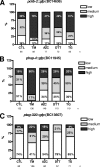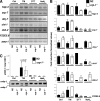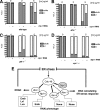GTPase-mediated regulation of the unfolded protein response in Caenorhabditis elegans is dependent on the AAA+ ATPase CDC-48
- PMID: 18458060
- PMCID: PMC2447140
- DOI: 10.1128/MCB.02252-07
GTPase-mediated regulation of the unfolded protein response in Caenorhabditis elegans is dependent on the AAA+ ATPase CDC-48
Abstract
When endoplasmic reticulum (ER) homeostasis is perturbed, an adaptive mechanism is triggered and named the unfolded protein response (UPR). Thus far, three known UPR signaling branches (IRE-1, PERK, and ATF-6) mediate the reestablishment of ER functions but can also lead to apoptosis if ER stress is not alleviated. However, the understanding of the molecular mechanisms integrating the UPR to other ER functions, such as membrane traffic or endomembrane signaling, remains incomplete. We consequently sought to identify new regulators of UPR-dependent transcriptional mechanisms and focused on a family of proteins known to mediate, among other, ER-related functions: the small GTP-binding proteins of the RAS superfamily. To this end, we used transgenic UPR reporter Caenorhabditis elegans strains as a model to specifically silence small-GTPase expression. We show that the Rho subfamily member CRP-1 is an essential component of UPR-induced transcriptional events through its physical and genetic interactions with the AAA+ ATPase CDC-48. In addition, we describe a novel signaling module involving CRP-1 and CDC-48 which may directly link the UPR to DNA remodeling and transcription control.
Figures








Similar articles
-
Genome-wide screen identifies a novel p97/CDC-48-dependent pathway regulating ER-stress-induced gene transcription.EMBO Rep. 2015 Mar;16(3):332-40. doi: 10.15252/embr.201439123. Epub 2015 Feb 4. EMBO Rep. 2015. PMID: 25652260 Free PMC article.
-
Genetic interactions due to constitutive and inducible gene regulation mediated by the unfolded protein response in C. elegans.PLoS Genet. 2005 Sep;1(3):e37. doi: 10.1371/journal.pgen.0010037. PLoS Genet. 2005. PMID: 16184190 Free PMC article.
-
Role of Unfolded Protein Response and Endoplasmic Reticulum-Associated Degradation by Repeated Exposure to Inhalation Anesthetics in Caenorhabditis elegans.Int J Med Sci. 2021 Jun 1;18(13):2890-2896. doi: 10.7150/ijms.58043. eCollection 2021. Int J Med Sci. 2021. PMID: 34220315 Free PMC article.
-
Small GTPases.WormBook. 2018 Aug 16;2018:1-65. doi: 10.1895/wormbook.1.67.2. WormBook. 2018. PMID: 27218782 Free PMC article. Review.
-
Maintenance of protein homeostasis in glia extends lifespan in C. elegans.Exp Neurol. 2021 May;339:113648. doi: 10.1016/j.expneurol.2021.113648. Epub 2021 Feb 15. Exp Neurol. 2021. PMID: 33600813 Free PMC article. Review.
Cited by
-
Strategic role of the ubiquitin-dependent segregase p97 (VCP or Cdc48) in DNA replication.Chromosoma. 2017 Feb;126(1):17-32. doi: 10.1007/s00412-016-0587-4. Epub 2016 Apr 18. Chromosoma. 2017. PMID: 27086594 Review.
-
XBP-1 is a cell-nonautonomous regulator of stress resistance and longevity.Cell. 2013 Jun 20;153(7):1435-47. doi: 10.1016/j.cell.2013.05.042. Cell. 2013. PMID: 23791175 Free PMC article.
-
An integrated PKD1-dependent signaling network amplifies IRE1 prosurvival signaling.J Biol Chem. 2019 Jul 19;294(29):11119-11130. doi: 10.1074/jbc.RA118.003311. Epub 2019 Jun 5. J Biol Chem. 2019. PMID: 31167779 Free PMC article.
-
Application of Caenorhabditis elegans for Research on Endoplasmic Reticulum Stress.Prev Nutr Food Sci. 2018 Dec;23(4):275-281. doi: 10.3746/pnf.2018.23.4.275. Epub 2018 Dec 31. Prev Nutr Food Sci. 2018. PMID: 30675455 Free PMC article. Review.
-
Protein misfolding induces hypoxic preconditioning via a subset of the unfolded protein response machinery.Mol Cell Biol. 2010 Nov;30(21):5033-42. doi: 10.1128/MCB.00922-10. Epub 2010 Aug 23. Mol Cell Biol. 2010. PMID: 20733002 Free PMC article.
References
-
- Ababou, M., S. Dutertre, Y. Lecluse, R. Onclercq, B. Chatton, and M. Amor-Gueret. 2000. ATM-dependent phosphorylation and accumulation of endogenous BLM protein in response to ionizing radiation. Oncogene 195955-5963. - PubMed
-
- Altan-Bonnet, N., R. Sougrat, and J. Lippincott-Schwartz. 2004. Molecular basis for Golgi maintenance and biogenesis. Curr. Opin. Cell Biol. 16364-372. - PubMed
Publication types
MeSH terms
Substances
LinkOut - more resources
Full Text Sources
Other Literature Sources
Research Materials
Miscellaneous
